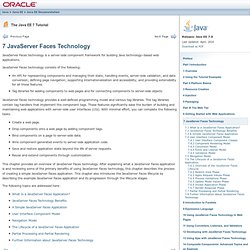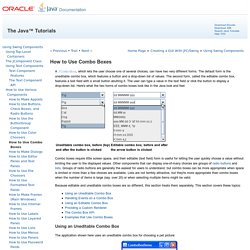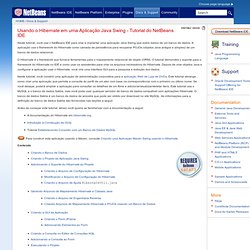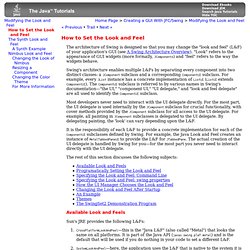

The Java EE 7 Tutorial:JavaServer Faces Technology. JavaServer Faces technology is a server-side component framework for building Java technology–based web applications.

JavaServer Faces technology consists of the following: An API for representing components and managing their state; handling events, server-side validation, and data conversion; defining page navigation; supporting internationalization and accessibility; and providing extensibility for all these featuresTag libraries for adding components to web pages and for connecting components to server-side objects JavaServer Faces technology provides a well-defined programming model and various tag libraries. The tag libraries contain tag handlers that implement the component tags. These features significantly ease the burden of building and maintaining web applications with server-side user interfaces (UIs). This chapter provides an overview of JavaServer Faces technology. The following topics are addressed here: Apostila Java para Desenvolvimento Web - Caelum. Java - How to tell which item fired a mouse listener. How to Use Combo Boxes (The Java™ Tutorials > Creating a GUI With JFC/Swing > Using Swing Components)
A JComboBox, which lets the user choose one of several choices, can have two very different forms.

The default form is the uneditable combo box, which features a button and a drop-down list of values. The second form, called the editable combo box, features a text field with a small button abutting it. The user can type a value in the text field or click the button to display a drop-down list. Here's what the two forms of combo boxes look like in the Java look and feel: Combo boxes require little screen space, and their editable (text field) form is useful for letting the user quickly choose a value without limiting the user to the displayed values.
Because editable and uneditable combo boxes are so different, this section treats them separately. Using an Uneditable Combo Box The application shown here uses an uneditable combo box for choosing a pet picture: The following code, taken from ComboBoxDemo.java, creates an uneditable combo box and sets it up: Note: Eclipse - The Eclipse Foundation open source community website.
Usando o Hibernate em uma Aplicação Java Swing - Tutorial do NetBeans IDE. Neste tutorial, você usa o NetBeans IDE para criar e implantar uma aplicação Java Swing que exibe dados de um banco de dados.

A aplicação usa o framework do Hibernate como camada de persistência para recuperar POJOs (objetos Java antigos e simples) de um banco de dados relacional. O Hibernate é o framework que fornece ferramentas para o mapeamento relacional de objeto (ORM). O tutorial demonstra o suporte para o framework do Hibernate no IDE e como usar os assistentes para criar os arquivos necessários do Hibernate. Depois de criar objetos Java e configurar a aplicação usar o Hibernate, você cria uma interface GUI para a pesquisa e exibição dos dados.
Neste tutorial, você constrói uma aplicação de administração corporativa para a aplicação Web de Loja de DVDs. Antes de começar este tutorial, talvez você queira se familiarizar com a documentação a seguir. Para construir esta aplicação usando o Maven, consulte Criando uma Aplicação Maven Swing usando o Hibernate. Conteúdo Observação. Certificação Java - Exam 1Z0-803. How to Set the Look and Feel (The Java™ Tutorials > Creating a GUI With JFC/Swing > Modifying the Look and Feel) The architecture of Swing is designed so that you may change the "look and feel" (L&F) of your application's GUI (see A Swing Architecture Overview).

"Look" refers to the appearance of GUI widgets (more formally, JComponents) and "feel" refers to the way the widgets behave. Swing's architecture enables multiple L&Fs by separating every component into two distinct classes: a JComponent subclass and a corresponding ComponentUI subclass. For example, every JList instance has a concrete implementation of ListUI (ListUI extends ComponentUI). The ComponentUI subclass is referred to by various names in Swing's documentation—"the UI," "component UI," "UI delegate," and "look and feel delegate" are all used to identify the ComponentUI subclass.
Most developers never need to interact with the UI delegate directly. It is the responsibility of each L&F to provide a concrete implementation for each of the ComponentUI subclasses defined by Swing. Questions containing 'jmenubar area filled' Warm Toolbar Icons Collection, Warm Toolbar Pack Free Download. Create a JButton that does not show focus : Button « Swing JFC Hibernate - JBoss Community.
Login.